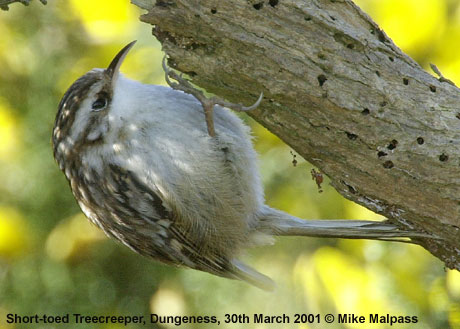
The Dungeness Short-toed Treecreeper Revisited

The most detailed response came from Laurent Raty (which you can read below). However, please note that after seeing these other photos from Mike (of the same bird), Laurent is now happy that this bird is a Short-toed Treecreeper and that the original photo was obscuring most of the features.
"I won't dispute the ID of the bird shown on Paul Hackett's two pictures, taken on 28, but I have quite a big concern about the bird photographed at the same location two days later by Mike Malpass. Among other, this last bird apparently had:
 - a whitish fore-supercilium, obvious in front of eye (virtually no trace of supercilium in front of eye on 28 March);
- a whitish fore-supercilium, obvious in front of eye (virtually no trace of supercilium in front of eye on 28 March);
- a long, pure white rear-supercilium, contrasting sharply against crown (shortish, strongly obscured by grey-brown flecking on 28 March);
- a rather thin and well-defined dark eye-stripe (broader, more diffuse and paler on 28 March);
- pure white ear-coverts centre (obviously grey-flecked on 28 March);
- an obvious dark crescent at the rear of ear coverts, similar in colour and broadness to eye-stripe (thinner dark crescent at rear of ear-coverts on 28 March, looking much thinner and perhaps slightly darker than eye-stripe);
- buff suffusion limited to the rear flanks (much more extensive and browner on 28 March);
- a mantle seeming quite variegated and contrasting, showing an admixture of black, buff and white flecks (greyer and plainer on 28 March, with pale marks limited to thin white shaft streaks);
- a rather shortish-looking bill, with quite continuously down-curved culmen (looking longer and with proximal half perhaps slightly straighter on 28 March);
- a strongly two-toned bill, with lower mandible straw-coloured, upper mandible blackish (less contrasted, lower mandible seeming dirty flesh and upper mandible greyer on 28 March);
- legs apparently straw-coloured (pinkish on 28 March).
I don't think this bird can be the same as the original Short-toed shown on the 28th March images. Differences in a bird's appearance on two pictures can occur due to differences in lighting and posture. This could be the explanation for some of the above but I find it very hard to believe this can explain everything. I'm fully convinced that a Short-toed was present on 28 March but I really wonder why the 30 March photo shows anything but a Common Treecreeper Certhia familiaris britannica.
Unfortunately, owing to the angle, many wing details can't be seen on Mike's picture. The longest feather of the bastard wing seems to show a complete white edge, connecting with its white tip, which normally supports Short-toed but is far from being diagnostic - identification of a treecreeper based a on single photograph can be extremely tricky. However, if the photographs indeed show two different individuals (which is what I really believe), it would obviously be more likely that the second bird is a local Common Treecreeper, rather than a second (seemingly strongly atypical) vagrant Short-toed.
If this is the case, it can have various implications: either two birds were present on 30 March and Mike Malpass simply photographed the wrong one, or all observers had moved on to watch a Common Treecreeper while the Short-toed was actually gone on that date."
Make your opinion known on the Surfbirds Discussion Board.
Many thanks to Mike Malpass and Paul Hackett for allowing use of their photos.
